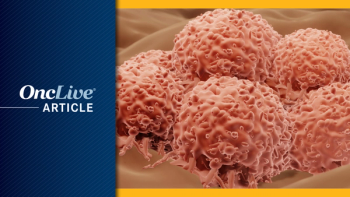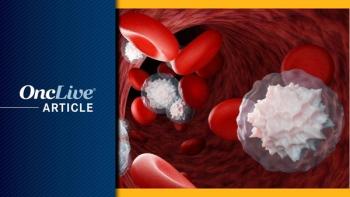
Balixafortide Plus Eribulin Fails to Improve ORR in Advanced HER2-Negative Breast Cancer
The combination of balixafortide and eribulin did not significantly improve objective response rate over eribulin alone in the treatment of patients with HER2-negative, locally recurrent or metastatic breast cancer, missing the co-primary end point of the phase 3 FORTRESS study.
The combination of balixafortide (POL6326) and eribulin (Halaven) did not significantly improve objective response rate (ORR) over eribulin alone in the treatment of patients with HER2-negative, locally recurrent or metastatic breast cancer, missing the co-primary end point of the phase 3 FORTRESS study (NCT03786094).1
At the time of the primary analysis, balixafortide plus eribulin elicited an ORR of 13.0% vs 13.7% with eribulin alone (P = 1.00) in patients who received treatment in the third-line setting (n = 330) and were followed for a minimum of 6 months. Moreover, the doublet resulted in a clinical benefit rate (CBR) of 16.7% vs 19.6% with eribulin alone in this population.
However, data from the study demonstrated a favorable safety and tolerability profile that aligns with what has been seen with balixafortide in a prior phase 1b study. The data from the study will continue to be evaluated and experts will decide about the future of the study in mid-July 2021, according to Polyphor AG.
“Given the high unmet medical need for patients with HER2-negative breast cancer in a late stage of the disease, we are disappointed that the FORTRESS study did not meet its co-primary end point,” Gökhan Batur, chief executive officer of Polyphor, stated in a press release. “We thank all the patients, investigators, and healthcare professionals, as well as our employees fpr their active participation in this study.”
In the international, multicenter, open-label phase 3 trial, investigators analyzed the safety, tolerability, and efficacy of intravenous balixafortide in combination with eribulin compared with eribulin alone in the treatment of patients with HER2-negative, locally recurrent or metastatic breast cancer.2
To be eligible for participation, patients needed to have histologically confirmed disease, stage IV or unresectable locoregionally recurrent disease, be refractory to the most recent chemotherapy, have acceptable organ function, and a life expectancy of at least 3 months. Moreover, patients could not have received prior cancer treatment within 14 days prior to study treatment.
Patients were excluded if they had prior eribulin, CXCR4 therapy, colony stimulating factors like filgrastim (Neupogen), pegfilgrastim (Neulasta), or sagramostim (Leukine), or radiation therapy within 2 weeks before day 1 of the study. Patients with grade 3 or higher peripheral neuropathy, who had a history of allergic reactions to compounds with a similar chemical or biologic composition, and those with congestive heart failure, electrolyte abnormalities, or bradyarrhythmia, could not participate.
A total of 432 patients were randomized on the trial; of these patients, 344 received the doublet in the third- or subsequent line and 88 patients received second-line chemotherapy.
The co-primary end points of the trial are ORR and progression-free survival, and a key secondary end point was CBR.
Previously, data from the phase 1 trial (NCT01837095) evaluating the doublet in patients with HER2-negative metastatic breast cancer showed that the regimen, when received in the second line or later, elicited an ORR of 37.5%, a median PFS pf 6.2 months, and a median overall survival (OS) of 18.0 months.3,4 The estimated 12-month OS rate with the doublet was 75%, and the 18- and 24-month estimates were 50% and 33.3%, respectively, in the expanded cohort.
In the overall efficacy population, the ORR achieved with balixafortide plus eribulin was 29.6%, the median PFS was 6.2 months, and the median OS was 16.8 months. The OS rates at 12, 18, and 24 months, were 62%, 42.4%, and 25%, respectively. The OS findings were observed irrespective of line of therapy, but the benefit was numerically higher in those who received the combination in the second-line or later setting.
References
- Polyphor provides update on the phase III FORTRESS study of balixafortide in patients with advanced HER2 negative breast cancer. News release. Polyphor AG. June 28, 2021. Accessed June 28, 2021.
https://bit.ly/2U9yo18 - Pivotal study in HER2 negative, locally recurrent or metastatic breast cancer (FORTRESS). ClinicalTrials.gov. Updated November 30, 2020. Accessed June 28, 2021.
https://clinicaltrials.gov/ct2/show/NCT03786094 - Pernas S, Martin M, Kaufman PA, et al. Balixafortide plus eribulin in HER2-negative metastatic breast cancer: a phase 1, single-arm, dose-escalation trial. Lancet Oncol. 2018;19(6):812-824. doi:10.1016/S1470-2045(18)30147-5
- Kaufman PA, Simon SP, Martin M, et al. Balixafortide (a CXVCR4 antagonist) + eribulin in HER2-negative metastatic breast cancer (MBC): survival outcomes of the phase I trial. J Clin Oncol. 2019;37(suppl 15):2606. doi:10.1200/JCO.2019.37.15_suppl.2606

























































































